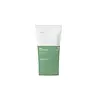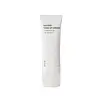What's inside
What's inside
 Key Ingredients
Key Ingredients

 Benefits
Benefits

 Concerns
Concerns

No concerns
 Ingredients Side-by-side
Ingredients Side-by-side

Water
Skin ConditioningZinc Oxide
Cosmetic ColorantCyclohexasiloxane
EmollientButyloctyl Salicylate
Skin ConditioningPropanediol
SolventPropylheptyl Caprylate
EmollientIsododecane
EmollientPolyglyceryl-3 Polydimethylsiloxyethyl Dimethicone
Skin ConditioningCaprylyl Methicone
Skin ConditioningDicaprylyl Carbonate
EmollientMethyl Methacrylate Crosspolymer
Polymethylsilsesquioxane
Centella Asiatica Extract
CleansingArtemisia Capillaris Extract
Houttuynia Cordata Extract
Skin ConditioningMelaleuca Alternifolia Leaf Extract
PerfumingSodium Hyaluronate
HumectantDisteardimonium Hectorite
StabilisingMagnesium Sulfate
Triethoxycaprylylsilane
1,2-Hexanediol
Skin ConditioningPolyglyceryl-2 Dipolyhydroxystearate
Skin ConditioningLauryl Polyglyceryl-3 Polydimethylsiloxyethyl Dimethicone
Skin ConditioningPhenyl Trimethicone
Skin ConditioningAcrylates/Dimethicone Copolymer
Skin ConditioningGlyceryl Caprylate
EmollientCaprylyl Glycol
EmollientEthylhexylglycerin
Skin ConditioningTocopherol
AntioxidantButylene Glycol
HumectantPentylene Glycol
Skin ConditioningWater, Zinc Oxide, Cyclohexasiloxane, Butyloctyl Salicylate, Propanediol, Propylheptyl Caprylate, Isododecane, Polyglyceryl-3 Polydimethylsiloxyethyl Dimethicone, Caprylyl Methicone, Dicaprylyl Carbonate, Methyl Methacrylate Crosspolymer, Polymethylsilsesquioxane, Centella Asiatica Extract, Artemisia Capillaris Extract, Houttuynia Cordata Extract, Melaleuca Alternifolia Leaf Extract, Sodium Hyaluronate, Disteardimonium Hectorite, Magnesium Sulfate, Triethoxycaprylylsilane, 1,2-Hexanediol, Polyglyceryl-2 Dipolyhydroxystearate, Lauryl Polyglyceryl-3 Polydimethylsiloxyethyl Dimethicone, Phenyl Trimethicone, Acrylates/Dimethicone Copolymer, Glyceryl Caprylate, Caprylyl Glycol, Ethylhexylglycerin, Tocopherol, Butylene Glycol, Pentylene Glycol
Water
Skin ConditioningDibutyl Adipate
EmollientTitanium Dioxide
Cosmetic ColorantGlycerin
HumectantPropanediol
SolventCaprylyl Methicone
Skin ConditioningPolyglyceryl-3 Methylglucose Distearate
EmulsifyingButylene Glycol
HumectantNiacinamide
SmoothingPolysilicone-15
UV FilterCetearyl Alcohol
Emollient1,2-Hexanediol
Skin ConditioningEthylhexyl Triazone
UV AbsorberPentylene Glycol
Skin ConditioningPolysorbate 60
EmulsifyingOenothera Biennis Flower/Leaf/Stem Extract
Skin ConditioningUlmus Davidiana Root Extract
Skin ConditioningPinus Palustris Leaf Extract
TonicPueraria Lobata Root Extract
HumectantOryza Sativa Extract
AbsorbentAvena Sativa Meal Extract
SoothingGlycine Max Seed Extract
Skin ConditioningSimmondsia Chinensis Seed Oil
EmollientGlyceryl Stearates
EmollientAdenosine
Skin ConditioningSqualane
EmollientPanthenol
Skin ConditioningBis-Ethylhexyloxyphenol Methoxyphenyl Triazine
Skin ConditioningPolymethylsilsesquioxane
Polyacrylate-13
Polyglyceryl-2 Caprate
EmulsifyingPolyacrylate Crosspolymer-6
Emulsion StabilisingAmmonium Acryloyldimethyltaurate/Vp Copolymer
Polyisobutene
Sucrose Stearate
EmollientEthylhexylglycerin
Skin ConditioningSodium Stearoyl Glutamate
CleansingStearic Acid
CleansingAlumina
AbrasiveXanthan Gum
EmulsifyingGlyceryl Caprylate
EmollientPolysorbate 20
EmulsifyingDisodium EDTA
Sorbitan Isostearate
EmulsifyingSodium Polyacrylate
AbsorbentT-Butyl Alcohol
PerfumingPolyether-1
Tocopherol
AntioxidantParfum
MaskingWater, Dibutyl Adipate, Titanium Dioxide, Glycerin, Propanediol, Caprylyl Methicone, Polyglyceryl-3 Methylglucose Distearate, Butylene Glycol, Niacinamide, Polysilicone-15, Cetearyl Alcohol, 1,2-Hexanediol, Ethylhexyl Triazone, Pentylene Glycol, Polysorbate 60, Oenothera Biennis Flower/Leaf/Stem Extract, Ulmus Davidiana Root Extract, Pinus Palustris Leaf Extract, Pueraria Lobata Root Extract, Oryza Sativa Extract, Avena Sativa Meal Extract, Glycine Max Seed Extract, Simmondsia Chinensis Seed Oil, Glyceryl Stearates, Adenosine, Squalane, Panthenol, Bis-Ethylhexyloxyphenol Methoxyphenyl Triazine, Polymethylsilsesquioxane, Polyacrylate-13, Polyglyceryl-2 Caprate, Polyacrylate Crosspolymer-6, Ammonium Acryloyldimethyltaurate/Vp Copolymer, Polyisobutene, Sucrose Stearate, Ethylhexylglycerin, Sodium Stearoyl Glutamate, Stearic Acid, Alumina, Xanthan Gum, Glyceryl Caprylate, Polysorbate 20, Disodium EDTA, Sorbitan Isostearate, Sodium Polyacrylate, T-Butyl Alcohol, Polyether-1, Tocopherol, Parfum
 Reviews
Reviews

Ingredients Explained
These ingredients are found in both products.
Ingredients higher up in an ingredient list are typically present in a larger amount.
1,2-Hexanediol is a synthetic liquid and another multi-functional powerhouse.
It is a:
- Humectant, drawing moisture into the skin
- Emollient, helping to soften skin
- Solvent, dispersing and stabilizing formulas
- Preservative booster, enhancing the antimicrobial activity of other preservatives
Butylene Glycol (or BG) is used within cosmetic products for a few different reasons:
Overall, Butylene Glycol is a safe and well-rounded ingredient that works well with other ingredients.
Though this ingredient works well with most skin types, some people with sensitive skin may experience a reaction such as allergic rashes, closed comedones, or itchiness.
Learn more about Butylene GlycolCaprylyl Methicone is a type of silicone.
It helps soften and soothe the skin by creating a thin film on top. This film helps trap moisture, keeping your skin hydrated.
Ethylhexylglycerin (we can't pronounce this either) is commonly used as a preservative and skin softener. It is derived from glyceryl.
You might see Ethylhexylglycerin often paired with other preservatives such as phenoxyethanol. Ethylhexylglycerin has been found to increase the effectiveness of these other preservatives.
Glyceryl Caprylate comes from glycerin and caprylic acid, a fatty acid from coconut. It has emollient and emulsifier properties.
As an emollient, it helps hydrate your skin. Emollients work by creating a barrier on your skin to trap moisture in, helping to keep your skin soft and smooth.
On the other hand, emulsifiers prevent ingredients (such as oil and water) from separating.
Learn more about Glyceryl CaprylatePentylene glycol is typically used within a product to thicken it. It also adds a smooth, soft, and moisturizing feel to the product. It is naturally found in plants such as sugar beets.
The hydrophilic trait of Pentylene Glycol makes it a humectant. As a humectant, Pentylene Glycol helps draw moisture from the air to your skin. This can help keep your skin hydrated.
This property also makes Pentylene Glycol a great texture enhancer. It can also help thicken or stabilize a product.
Pentylene Glycol also acts as a mild preservative and helps to keep a product microbe-free.
Some people may experience mild eye and skin irritation from Pentylene Glycol. We always recommend speaking with a professional about using this ingredient in your routine.
Pentylene Glycol has a low molecular weight and is part of the 1,2-glycol family.
Learn more about Pentylene GlycolPolymethylsilsesquioxane is a silicone used as a film forming agent.
When applied to the skin, this ingredient creates an invisible film on the surface. This film still allows oxygen to pass through, but prevents moisture from escaping. This can help condition and hydrate the skin. It also leaves a silky feel when applied.
Polymethylsilsesquioxane has not been shown to clog pores. It has been deemed safe to use up to 55%, but most cosmetics use much less.
If you have concerns about using this ingredient, we recommend speaking with a professional.
Learn more about PolymethylsilsesquioxanePropanediol is an all-star ingredient. It softens, hydrates, and smooths the skin.
It’s often used to:
Propanediol is not likely to cause sensitivity and considered safe to use. It is derived from corn or petroleum with a clear color and no scent.
Learn more about PropanediolTocopherol (also known as Vitamin E) is a common antioxidant used to help protect the skin from free-radicals and strengthen the skin barrier. It's also fat soluble - this means our skin is great at absorbing it.
Vitamin E also helps keep your natural skin lipids healthy. Your lipid skin barrier naturally consists of lipids, ceramides, and fatty acids. Vitamin E offers extra protection for your skin’s lipid barrier, keeping your skin healthy and nourished.
Another benefit is a bit of UV protection. Vitamin E helps reduce the damage caused by UVB rays. (It should not replace your sunscreen). Combining it with Vitamin C can decrease sunburned cells and hyperpigmentation after UV exposure.
You might have noticed Vitamin E + C often paired together. This is because it is great at stabilizing Vitamin C. Using the two together helps increase the effectiveness of both ingredients.
There are often claims that Vitamin E can reduce/prevent scarring, but these claims haven't been confirmed by scientific research.
Learn more about TocopherolWater. It's the most common cosmetic ingredient of all. You'll usually see it at the top of ingredient lists, meaning that it makes up the largest part of the product.
So why is it so popular? Water most often acts as a solvent - this means that it helps dissolve other ingredients into the formulation.
You'll also recognize water as that liquid we all need to stay alive. If you see this, drink a glass of water. Stay hydrated!
Learn more about Water